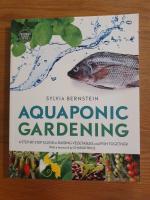
Aquaponic gardening - a step-by-step guide to raising vegetables and fish together
Häftad bok. 2013. 256 sidor.
Nära nyskick.
Förlagsfakta
- ISBN
- 9781908643087
- Titel
- Aquaponic gardening - a step-by-step guide to raising vegetables and fish together
- Författare
- Bernstein, Sylvia
- Utgivningsår
- 2013
- Bandtyp
- Språk
- English
- Baksidestext
- Aquaponics is a revolutionary system for growing plants by fertilising them with the waste water from fish in a sustainable closed system. A combination of the best of aquaculture and hydroponics, aquaponic gardening is an amazingly productive way to grow organic vegetables, greens, herbs and fruits, while providing the added benefits of fresh fish as a safe, healthy source of protein. On a larger scale, it is a key solution to mitigating food insecurity, climate change, groundwater pollution and the impacts of overfishing on our oceans. This is the definitive do-it-yourself home manual, with an introduction by Charlie Price, head of Aquaponics UK. It focuses on giving you all the tools you need to create your own aquaponic system and enjoy healthy, safe, fresh and delicious food all year round. Starting with an overview of the theory, benefits and potential of aquaponics, this book goes on to explain: system location considerations and hardware components; the living elements - fish, plants, bacteria, and worms; and, putting it all together - starting and maintaining a healthy system. Aquaponics systems are completely organic. They are four to six times more productive and use 90 percent less water than conventional gardens. Other advantages include no weeds, fewer pests, and no watering, fertilising, bending, digging, or heavy lifting - in fact, there really is no down side! Anyone interested in taking the next step towards self-sufficiency will be fascinated by this practical, accessible and well-illustrated guide.




















